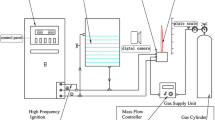Abstract
The characteristics of the plasma jet emanating from a dc non-transferred plasma torch is affected by many factors including arc current, type of gas, gas flow rate, gas injection configuration and torch geometry. The present work focuses on experimental investigation of the influence of shroud gas injection configuration on the I–V characteristics and electro-thermal efficiency of a dc non-transferred plasma torch operated in nitrogen at atmospheric pressure. The plasma gas is injected into the torch axially and shroud gas is injected through three different nozzles such as normal, sheath and twisted nozzles. The effects of flow rates of plasma/axial gas and arc current on I–V characteristics and electro-thermal efficiency of the torch holding different nozzles are investigated. The I–V characteristics and electro-thermal efficiency of the torch are found to be strongly influenced by the shroud gas injection configuration. The effect of arc current on arc voltage decreases with increasing the axial gas flow rate. At higher axial gas flow rate (> 45 lpm), the I–V characteristics of the plasma torch are similar irrespective of the nozzle used. The variation of electro-thermal efficiency with arc current is almost similar to that of arc voltage with arc current. As expected, the electro-thermal efficiency is increased when the axial gas flow rate is increased and at higher axial gas flow rate, it is not influenced by the arc current and shroud gas configuration. The plasma torch with normal nozzle may be better in the range of operating conditions used in this study.









Similar content being viewed by others
References
Boulos MI, Fauchais P, Pfender E (1994) Thermal plasma, vol. 1: fundamentals and application. Plenum Press, New York
Boulos MI (1991) Thermal plasma processing. IEEE Trans Plasma Sci 19:1078–1089
Taylor PR, Pirzada SA (1994) Thermal plasma processing of materials: a review. Adv Perform Mater 1:35–50
Fauchais P, Montavon G, Vardelle M, Cedelle J (2006) Developments in direct current plasma spraying. Surf Coat Technol 201:1908–1921
Gomez E, Rani DA, Cheeseman CR, Deeganc D, Wise M, Boccaccinia AR (2009) Thermal plasma technology for the treatment of wastes: a critical review. J Hazard Mater 161:614–626
Seo JH, Hong BG (2012) Thermal plasma synthesis of nano-sized powders. Nucl Eng Technol 44:9–20
Cheron BG, Bultel A, Delair L (2007) Experimental Study of a double arc nitrogen plasma: static and dynamic behavior. IEEE Trans Plasma Sci 35:498–508
Kurtz MA, Kurtz HL, Laure S (1996) Plasma generators for re-entry simulation. J Propul Power 12:1053–1061
Fauchais P, Vardelle A (2000) Pending problems in thermal plasmas and actual development. Plasma Phys Control Fus 42:B365–B383
Zhukov MF, Zasypin IM (2007) Thermal plasma torches: design, characteristics, applications. Cambridge International Science Publishing, Cambridge
Cao X, Yu D, Xiang Y, Yao J (2016) Influence of the gas injection angle on the jet characteristics of a non-transferred dc plasma torch. Plasma Chem Plasma Process 36:881–889
Felipini CL, Pimenta MM (2015) Some numerical simulation results of swirling flow in d.c. plasma torch. J Phy Conf Ser 591:1–13
Moon J-H, Jan J-G, Kim YJ (2005) Performance of an atmospheric plasma torch with various inlet angles. Surf Coat Technol 193:94–100
Yuan XQ, Li H, Zhao TZ, Wang F, Gou WK, Xu P (2004) Comparative study of flow characteristics inside plasma torch with different nozzle configurations. Plasma Chem Plasma Process 24:585–601
Kang KD, Hong SH (1999) Numerical analysis of shroud gas effects on air entrainment into thermal plasma jet in ambient atmosphere of normal pressure. J Appl Phys 85:6373–6380
Gross B, Grycz B, Miklossy K (1968) Plasma technology. Iliffe Books Ltd, London
Ramachandran K, Marques J-L, Vaßen R, Stöver D (2006) Modelling of arc behavior inside a F4 APS torch. J Phys D Appl Phys 39:3323–3331
Shicong B, Wenkang G, Minyou YE, Ping XU, Xiaodong Z (2008) Characteristics and thermal efficiency of a non-transferred DC plasma spraying torch under low pressure. Plasma Sci Technol 10:701–705
Author information
Authors and Affiliations
Corresponding author
Rights and permissions
About this article
Cite this article
Yugesh, V., Ravi, G., Ramachandran, K. et al. Influence of the Shroud Gas Injection Configuration on the Characteristics of a DC Non-transferred Arc Plasma Torch. Plasma Chem Plasma Process 38, 759–770 (2018). https://doi.org/10.1007/s11090-018-9890-6
Received:
Accepted:
Published:
Issue Date:
DOI: https://doi.org/10.1007/s11090-018-9890-6




